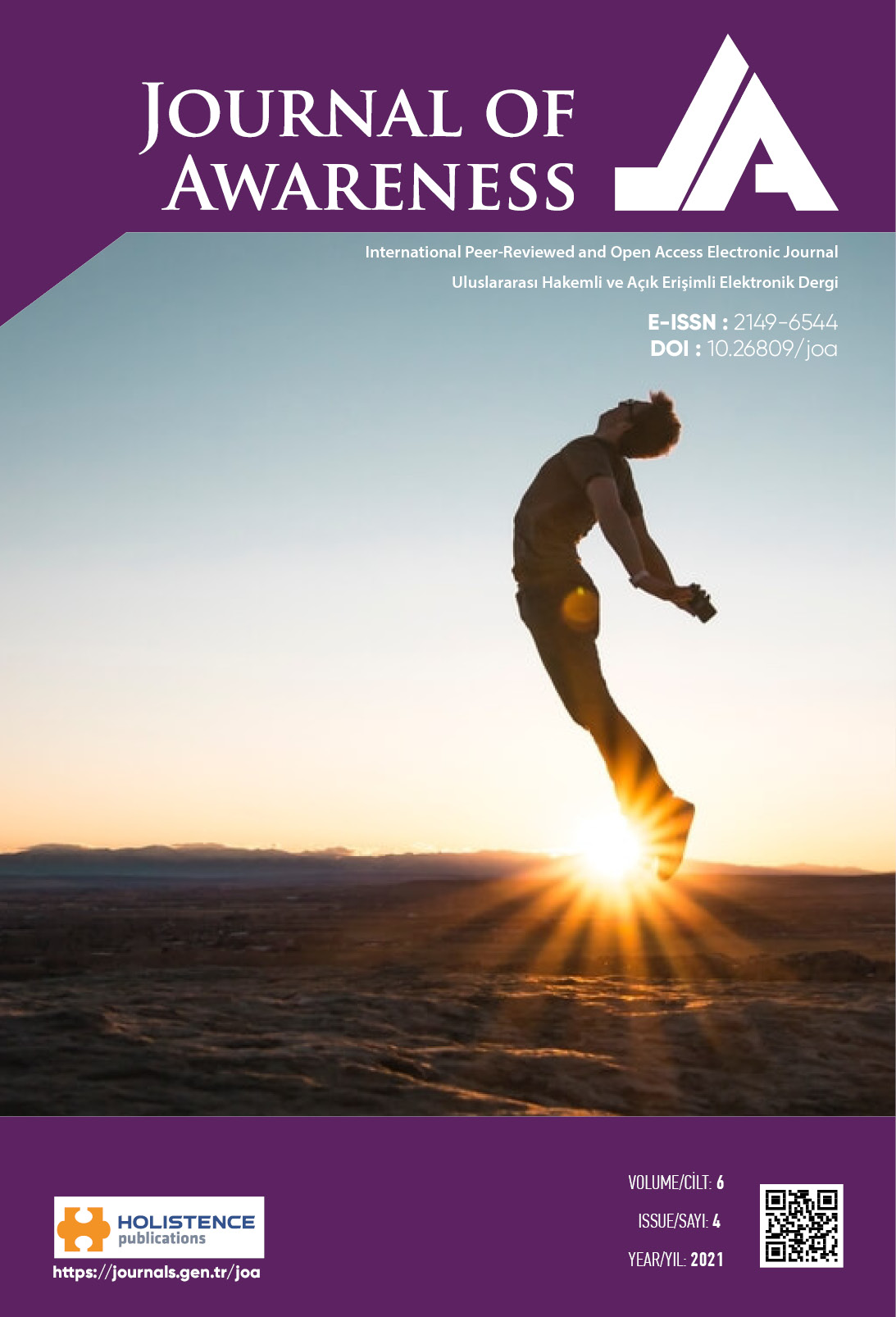The relationship between methods of coating with stress and smoking addiction of the employees in educational institutions
DOI:
https://doi.org/10.26809/joa.6.4.07Keywords:
Stress, stress coping styles, smoking, nicotinAbstract
The aim of this research is to examine the relationship between methods of coping with stress and smoking addiction of the employees in educational institutions and to investigate how these scales differ in terms of demographic characteristics. The population of the research consists of smokers between the ages of 18-65 who reside in Istanbul and voluntarily agree to participate in our research. While selecting the participants, convenient sampling, which is one of the non-probability sampling methods, was used. Personal Information Form, Coping Styles Inventory and Fagerström Nicotine Dependence Test were used in the study. The data were analyzed with the SPSS 25.0 statistical program. In the study, significant differences were found in terms of gender, age, education and income variables, according to the scores obtained from the inventory of coping styles and sub-dimensions. Significant differences were found in the Fagerström Test for Nicotine Addiction scores in terms of gender, income, education and age. It has been determined that there is a statistically significant negative correlation between the Stress Coping Styles Inventory and its sub-dimensions, Self-Confident Approach, Optimistic Approach, Helpless Approach, and Fagerström Nicotine Dependence Test scores. It was found that the methods of coping with stress and cigarette addiction scores of the participants differed according to their sociodemographic characteristics.
In the general results, it is recommended to organize information and training to improve coping skills with stress coping styles inventory and its sub-dimensions, self-confident approach, optimistic approach and helpless approach.
Downloads
References
BAL, F. (2019). Şema terapinin sigarayı bırakma davranışı üzerindeki etkisinin incelenmesi. Avrasya Sosyal ve Ekonomi Araştırmaları Dergisi, 6(1), 187-199.
BASUT, E. (2006). Stres, başa çıkma ve ergenlik. Çocuk ve Gençlik Ruh Sağlığı Dergisi, 13(1),31-36.
BAYKAN, Z. & NAÇAR, M. (2014). Tıp fakültesi öğrencilerinin sigara kullanımı ve tütün kanununa ilişkin görüşleri. Dicle Tıp Dergisi,41(3),483-490.
BİBER, K., CANKORUR, H., AYDEMİR, E. A. VE GÜLER, R. S. (2019). Okul öncesi öğretmen ve öğretmen adaylarının stresle başa çıkma tarzları. Uşak Üniversitesi Eğitim Araştırmaları Dergisi, 5(2), 32-62.
BULUT, N. (2005). İlköğretim öğretmenlerinde, stres yaratan yaşam olayları ve stresle başa çıkma tarzlarının çeşitli değişkenlerle ilişkisi, Kastamonu Eğitim Dergisi, 13(2), 467-478.
ÇELEPKOLU, T., ATLI, A., PALANCI, Y., YILMAZ, A., DEMİR, S., İBİLOĞLU, A. O. & EKİN, S. (2014). Sigara kullanıcılarda nikotin bağımlılık düzeyinin yaş ve cinsiyetle ilişkisi: Diyarbakır örneklemi. Dicle Tıp Dergisi, 41(4), 712-716
DEMİR, T., TUTLUOĞLU, B., KOÇ, N. & BİLGİN, L. (2004). Sigara bırakma polikliniğimizin bir yıllık izlem sonuçları. Tüberküloz ve Toraks Dergisi, 52(1), 63-68.
FOLKMAN, S. & LAZARUS, R.S. (1986). Appraisal, coping, health status and psychological symptoms. J Pers Soc Psychol, 50,571-579.
FROYEN, A. (1988). Classroom management. Ohio: Merrill Publishingi Company.
GÖKLER, R. (2012). Modern çağın hastalığı; stres ve etkileri/the disease of modern era; stress and its effects. Journal of History Culture and Art Research, 1(3), 154-168.
GRAHAM, H. (1999). Stresi kendi yararınıza kullanın. İstanbul: Alfa Yayınları.
IVANCEVICH, J. M., MATTESON, M. T. & KONOPASKE, R. (1990). Organizational behavior and management
KAYA, M., GENÇ, M., KAYA, B., & PEHLİVAN, E. (2007). Tıp fakültesi ve sağlık yüksekokulu öğrencilerinde depresif belirti yaygınlığı, stresle başa çıkma tarzları ve etkileyen faktörler. Türk Psikiyatri Dergisi, 18(2), 137-146.
KETEN, H. S., KAHRAMAN, H., ÜÇER, H., ÇELİK, M., SUCAKLI, M. H. & ERSOY, Ö. (2014). Aile hekimlerinin sigara bağımlılığı tedavisi konusundaki bilgi, tutum ve uygulamaları. Türkiye Aile Hekimliği Dergisi, 18(2), 58-62.
KOÇHAN, K. & İLHAN, T. (2015). Erbaş/Erlerin Ebeveyne Bağlanma Stilleri, Depresyon Düzeyleri ve Stresle Başa Çıkma Stillerinin Madde Kullanımı Açısından İncelenmesi. Addicta: The Turkish Journal on Addictions, 2(2), 61-109.
KRAAİJ, V., GARNEFSKI, N. & MAES, S. (2002). The joint effects of stress, coping, and coping resources on depressive symptoms in elderly. Anxiety Stress Coping, 15,163.
Okutan, O., Taş, D., Kaya, H. ve Kartaloğlu, Z. (2007). Sigara içen sağlık personelinde nikotin bağımlılık düzeyini etkileyen faktörler. Tüberküloz ve Toraks Dergisi, 55(4), 356-363.
ÖZARSLAN, Z., FISTIKÇI, N., KEYVAN, A., UĞURAD, Z. I. & SAYGILI, S. (2013). Depresyon hastalarının stres ile başa çıkma stratejileri. Marmara Medical Journal, 26,130-5.
SCHERMERON, R. J. (1989). Management For Productuvity. New York.
SELYE, H. (1974). Stress without distress. NY: J.B.Lippincott.
SELYE, H. (1976). Stress in health and disease. Boston: Butterworths.
WERDEN, E. M. (2001). Religious identity as a coping resource. Miami University.
YAKAR, B. ve Pirinççi, E. (2019). Bir üniversite hastanesi polikliniğine başvuran hastaların sigara ve alkol bağımlılık düzeylerine etki eden faktörler. Kahramanmaraş Sütçü İmam Üniversitesi Tıp Fakültesi Dergisi, 14(2), 57-65.
YILMAZ, T. & OSKAY, Ü. Y. (2015). İnfertilite stresi ile başa çıkma yöntemleri ve hemşirelik yaklaşımları. Sağlık Bilimleri ve Meslekleri Dergisi, 2(1), 100-112.
Downloads
Published
How to Cite
Issue
Section
License
Copyright (c) 2021 Holistence Publications

This work is licensed under a Creative Commons Attribution 4.0 International License.
When the article is accepted for publication in the Journal of Awareness, authors transfer all copyright in the article to the Rating Academy Ar-Ge Yazılım Yayıncılık Eğitim Danışmanlık ve Organizasyon Ticaret Ltd. Şti.The authors reserve all proprietary right other than copyright, such as patent rights.
Everyone who is listed as an author in this article should have made a substantial, direct, intellectual contribution to the work and should take public responsibility for it.
This paper contains works that have not previously published or not under consideration for publication in other journals.











